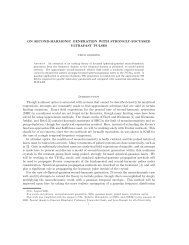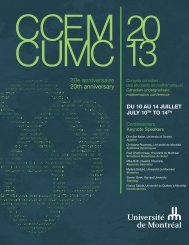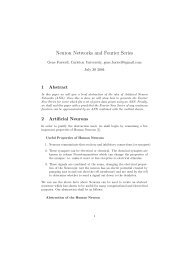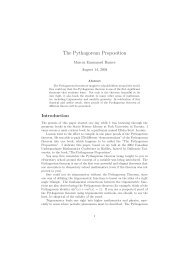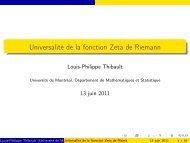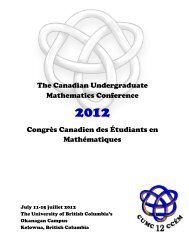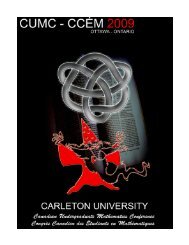booklet - CUMC - Canadian Mathematical Society
booklet - CUMC - Canadian Mathematical Society
booklet - CUMC - Canadian Mathematical Society
Create successful ePaper yourself
Turn your PDF publications into a flip-book with our unique Google optimized e-Paper software.
CHAOS THEORYANDREW FLECKA review of some of the basic results in Chaos and Non-Linear dynamics beginningwith 2 dimensional non-linear systems and working up to higher dimensional chaoticsystems. Features of lower dimensional non-linear systems of ODE’s and their solutionswill be discussed with examples in the sciences. The Poincare-Bendixion theoremand attractors will be presented with their implications for the formation of chaos. Followingthis will be an examination of the different definitions of chaos and illustrationsof chaos in the Lorenz system and the driven pendulum. Time permitting; applicationsin messaging and attractor reconstruction will also be presented.LES SYMÉTRIES DE L’ÉQUATION DE HELMHOLTZANDRÉANNE LAPOINTEIntroduit par Sophus Lie dans le but initial d’étudier certaines propriétés des équationsdifférentielles, les groupes de Lie se retrouvent maintenant dans de nombreusessphères de la physique et des mathématiques. Cette conférence aura donc pour but enpremier lieu de présenter une introduction simple des groupes de Lie qui nous permettronsde voir la définition de générateurs infinitésimaux, de commutateurs et d’algèbrede Lie. Par la suite, nous utiliserons les concepts introduits en première partie pourobserver l’intime liaison qu’ont ces groupes avec les symétries à travers un exempleconcret, celui de l’équation différentielle de Helmholtz.BITCOIN - NEW ERA OF CURRENCYANJA RADAKOVICThe talk will be given about a fairly new technology that is still in the experimentalphase, called Bitcoin. Bitcoin is a digital currency, but it also creates its own economy.Satoshi Nakamoto first described it in 2008 as a "peer-to-peer, electronic cash system".This is because Bitcoin does not have any central authority like other currency. Thisdigital currency uses an open source cryptographic protocol in order to transfer thebitcoins. The aspects which will be covered are what Bitcoin is, how it came about,what technology it uses, and how new bitcoins are made. Finally, we will examine thecurrent state of the digital currency and where it is going.SCHEDULING PROBLEMSANNAMARIA DOSSEVAAn overview of a few optimization problems which can be posed as schedulingproblems. These problems come up everywhere: which of your school assignments doyou start first; how does an airport assign gates to planes, or employees to work shifts;or how do you best design your program to schedule tasks on a CPU?We’ll start with a basic introduction to scheduling, including definitions and a fewsimple examples. We will use some of these examples to illustrate polynomial-time reductions,the problem classes P and NP, approximation algorithms, and the techniqueof dynamic programming (DP). Finally, we’ll finish by describing the Knapsack prob-17



